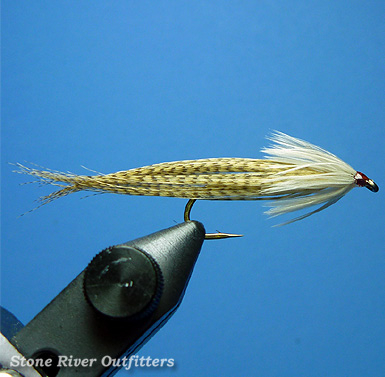
The Wood Duck Heron
A regional favorite from noted New Hampshire fly fishing and fly tying legend Nick Lambrou, the Woodduck Heron has proven deadly not only for brook, brown and rainbow trout, but has taken more than its fair share of landlocked Atlantic salmon as well. Though originally tied to represent an emerging hexagenia mayfly, this pattern also does an excellent job mimicking small baitfish like smelt, dace, and other natural-found forage fish too.
Recipe / Materials List
- Hook: 2xl to 3xl Nymph/Streamer
- Thread: 6/0 or 8/0 (color of choice)
- Wing: Natural Lemon Wood Duck or Dyed Imitation
- Collar: Light Dun Hen Neck or Saddle Feather (or color of choice)
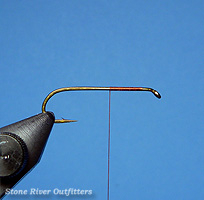 Step 1: Start your thread behind the hook eye and wrap a smooth, even thread-base rearward towards the hook bend being sure to stop just shy of the hook shank's halfway point.
Step 1: Start your thread behind the hook eye and wrap a smooth, even thread-base rearward towards the hook bend being sure to stop just shy of the hook shank's halfway point.
***Special Notes: While most tying threads will indeed suffice, we prefer Danville's 6/0 Flymaster (70 denier) as it can be easily relaxed and flattened by simply spinning your bobbin. Rounder threads such as Uni 6/0 or 8/0 can be used, but they have a tendency to build a ridged, somewhat lumpy base that can prove problematic in future steps!
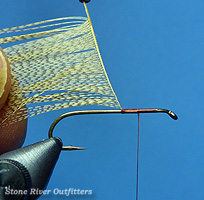 Step 2: Select an appropriately sized Lemon Woodduck Feather and tie it in securely on the near-side of the hook shank, tip-first and curved-side down. Once secured, carefully grasp the feather's stem with hackle pliers and gently sweep and fold the feather's barbules rearward, as shown.
Step 2: Select an appropriately sized Lemon Woodduck Feather and tie it in securely on the near-side of the hook shank, tip-first and curved-side down. Once secured, carefully grasp the feather's stem with hackle pliers and gently sweep and fold the feather's barbules rearward, as shown.
***Special Notes: An appropriately sized feather should ideally feature barbules that measure approximately 1 to 1.5 times the length of the selected hook's shank. Naturally, with prime extra-large Lemon Woodduck plumage quite expensive and often in short supply, you might find an expertly-dyed high-quality Mallard Flank feather like ours from Nature's Spirit, a useful and more cost effective substitute!
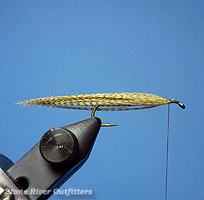 Step 3: Using your hackle pliers for extra control, carefully wrap the Lemon Woodduck feather forward towards the hook eye in palmered fashion, leaving a slight space between each turn, then tie the Woodduck off snugly and closely trim the excess away.
Step 3: Using your hackle pliers for extra control, carefully wrap the Lemon Woodduck feather forward towards the hook eye in palmered fashion, leaving a slight space between each turn, then tie the Woodduck off snugly and closely trim the excess away.
***Special Notes: Lemon Woodduck, Mallard Flank, and many other waterfowl feathers have a conveniently oval-shaped stem that lends itself well for folding and wrapping. Be sure to find then exploit this natural flat with every slightly spaced turn, and don't be afraid to gently stroke the feather's barbules softly rearward with your offhand between each wrap to keep the fibers tamed too!
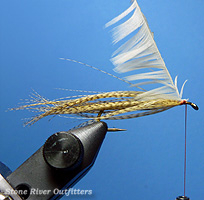 Step 4: Select an appropriately sized soft, webby Hen Neck or Hen Saddle Feather and tie it in securely on the near-side of the hook shank, tip-first, curved-side down just forward of the bound Lemon Woodduck. Carefully grasp the hen feather's stem with your hackle pliers, then gently sweep and fold the feather's barbules rearward, as shown.
Step 4: Select an appropriately sized soft, webby Hen Neck or Hen Saddle Feather and tie it in securely on the near-side of the hook shank, tip-first, curved-side down just forward of the bound Lemon Woodduck. Carefully grasp the hen feather's stem with your hackle pliers, then gently sweep and fold the feather's barbules rearward, as shown.
***Special Notes: Folding your collar hackles is an incredibly handy technique that will lessen your frustrations when both wrapping and finishing not only this, but most any wet fly or streamer pattern! Stay tuned for a future tutorial on folding tips and tricks, or stop by the shop sometime and ask Dan or Nate for a first-person demonstration.
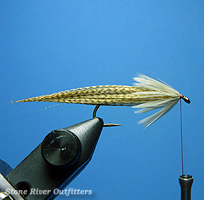 Step 5: Using your hackle pliers for extra control, carefully wrap the hen hackle forward placing each successive turn immediately in front of the last, being cautious not to overcrowd the hook eye. Snugly tie the hen hackle down using a couple of well placed thread wraps, then trim the excess stem away closely at the base.
Step 5: Using your hackle pliers for extra control, carefully wrap the hen hackle forward placing each successive turn immediately in front of the last, being cautious not to overcrowd the hook eye. Snugly tie the hen hackle down using a couple of well placed thread wraps, then trim the excess stem away closely at the base.
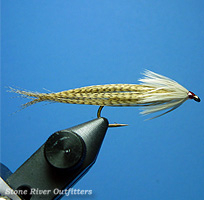 Step 6: Neatly build a small and evenly tapered head, whip finish, and apply cement.
Step 6: Neatly build a small and evenly tapered head, whip finish, and apply cement.
Summary / Closing Remarks: There you have it folks! A proven producer that's sure to please, try substituting different colors of hen hackle when collaring this fly to create your own uniquely personalized adaptation of this popular New Hampshire favorite. As always, have fun with this one gang. Thanks so much for all your support, and please don't hesitate to call on us if we can be of further assistance! Sincerely - Nate Harris

